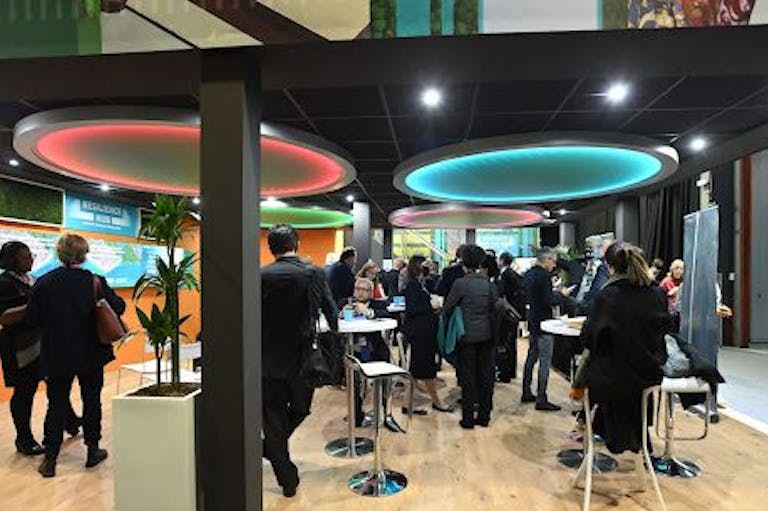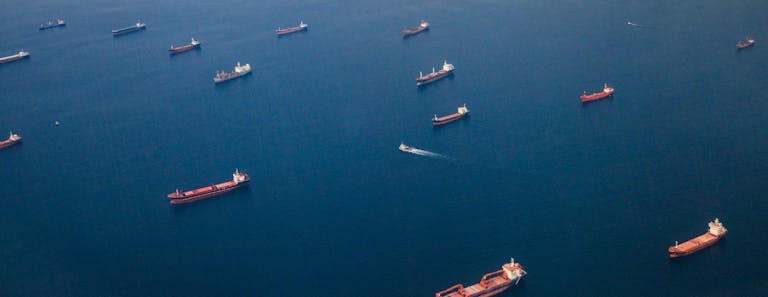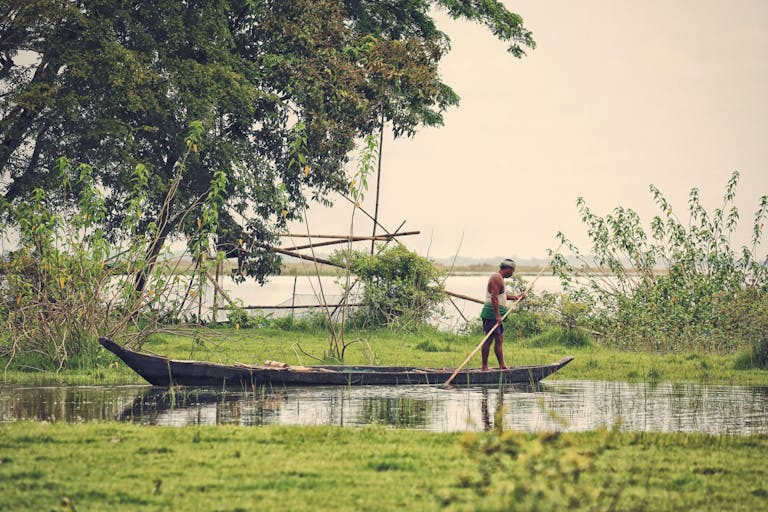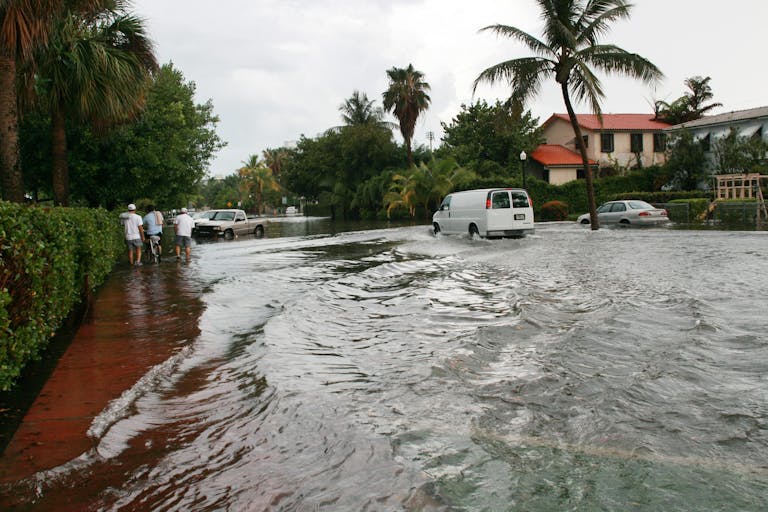From producing half of the planet’s oxygen to providing food for billions of people, oceans are vital for our survival. This is also true when it comes to fighting climate change. “The oceans can essentially save us from ourselves,” Susan says.
Susan served as a delegate and speaker at the UN Climate Change Conference (COP26) in Glasgow, Scotland, which brought together world leaders, CEOs, scientists, and activists to discuss curbing greenhouse gas emissions. Building a net-zero future — which refers to balancing overall emissions by offsetting or removing carbon from the atmosphere via nature, new technology, or new industrial practices — is the most urgent challenge of our time.
From Susan’s perspective, the world’s oceans hold many of the answers as to how we’re going to get there.
Q: Let’s start by talking about COP26 in Glasgow. I’d love to hear what an insider’s view of that experience was like.
Susan Ruffo: COP26 was a good milestone. We all came away knowing we need to do more. We have to do more — and more quickly. It was heartening to see how many people came and showed up in the streets and all of the governments and companies that were there. And I think that’s the part where I take hope, because those are the people who will carry this forward and who will actually make something happen on the ground.

For issues around oceans, there was an unprecedented participation by certain sectors like shipping. It’s a hard-to-abate sector that has been left out of a lot of conversations. But at this COP, we had not only shipping companies, but also the companies that are customers of shipping companies, like Ikea and Amazon, demanding zero-emissions shipping for their products. We had people representing seafarers. We had countries standing up and saying they could be green fuels producers. We even had the International Maritime Organization, which is a completely separate organization from the UNFCCC [United Nations Framework Convention on Climate Change], saying they need to be part of the mix. What we need now is to make sure that is followed up with action.
Why do you think there’s this sudden realization? Obviously, this summit was held against the backdrop of an ongoing supply chain debacle.
I think that’s definitely one reason why some people are paying a bit more attention. I mean, 80% of goods around the world are moved by ship. I think a lot of people just don’t realize how far these products travel to reach our stores. Yet maritime shipping was one of the few sectors left out of the language of the Paris Agreement because it crosses national boundaries. It is a great example of why the world really needs to come together to solve the climate crisis.
I want to dig into what green fuels look like. What does it mean for the shipping industry to achieve net-zero in practical terms?
In practical terms, it probably means a lot of different things. It’s not going to be one solution. In the short term, it means figuring out how we can be more efficient with the fuels that we have. In the longer — but not long! — term, it means radically changing the fuels that ships run on. There’s everything from wind-powered ships that are being piloted to battery-operated ships for shorter distances. Then there are green fuels, like green ammonia.

Some of the commitments made at COP were around building what they’re calling “green corridors” for shipping. So it’s more than just about the ships themselves. It’s about this entire infrastructure and system built around it. If you think about things like environmental justice around ports and pollution around ports, there’s potential to really solve a multitude of problems.
It seems like we’re witnessing a shift away from focusing on what individual consumers can do when it comes to climate action and more about holding industry leaders accountable. I’d love to talk about the UN Foundation’s work bringing businesses to the table and convincing the CEOs of the world that sustainability is good for the bottom line, as well as the planet.
It is really important to have corporations be part of the solution. Much of this work is a combination of getting the first movers out there who are really willing to step up and say, ‘Yes, we’re going to lead this movement and get ahead of it and do the right thing.’ These companies help set a high bar.
I think there’s also a really important role for policy in making sure that the bottom is also brought up. So those companies that are less forward-leaning get brought along, too. When you think about progress behind a potential plastics treaty, for instance, how do we bring companies and governments together to really understand that link between the first adopters and policies that reinforce each other?
I want to talk about the link between our oceans and food. Similar to shipping, I think it’s easy to overlook how integral the oceans are to sustaining the global food chain.
Yes, there are basically 3 billion people in the world who get a significant portion of their protein from the ocean. And a lot of those people live in very vulnerable countries as small-scale fishers. So when we think about the food crisis and how we feed the future amid climate change, if we don’t think about the ocean, then we’re missing out not only on a lot of people, but a lot of very vulnerable people.

And the food security impact of climate change could be really devastating when you start to think about people migrating and competing for resources. So protecting the ocean — and the ocean as a source of food in particular — is really important.
Some of the work that’s been launched at COP — like the AIM for Climate partnership, which the UN Foundation has been a part of — is really looking at agricultural innovation and climate-smart food production. I think when we’re thinking about that, we also have to think about how the two intersect: How does food production on land also impact the ocean? Because anything you put on land will eventually flow down our rivers and streams and into the ocean. So how do we innovate the ways we’re fertilizing land, but not in a way that’s going to impact these small scale-fishers along the coast of these vulnerable countries? There’s a lot of work that still needs to be done in thinking about these things holistically.
That’s such a good point about the inherent, but often overlooked, connection between the land and the sea and why they can’t be addressed as separate entities.
I want to talk about how unique the ocean is in terms of management. No one owns the ocean. What is the role of the international community, the UN, NGOs, and organizations like the UN Foundation in helping protect this shared and precious resource?
The ocean is interesting because it’s 70% of the planet, but really the jurisdiction over the ocean is very complicated and, for a big portion of it, there’s really no jurisdiction at all. In the U.S., for instance, the first three miles from the coast are under state authority, 12 miles out from the coast are under national authority. Two hundred miles out from the coast is still national jurisdiction, and anything beyond that is just international waters. So, that’s complicated enough — and that’s just one country.
And you think about where those circles overlap or where they don’t. It’s probably two-thirds of the ocean that’s high seas. They call those “areas beyond national jurisdiction.” That’s where the UN has a really important role because it’s arrangements like the treaty that’s being negotiated now to deal with biodiversity beyond areas of national jurisdiction, or like the International Seabed Authority, or the International Maritime Organization that make up a web of different agreements to try to deal with things like fishing and mining and drilling and shipping.
But several of those were created as early as the 1950s, so they don’t take climate change into account. Right now we have an opportunity to really think about what climate change means because the ocean is one big system and we’re already seeing species moving. Ice is melting in places that we thought were relatively stable. So dealing with all of that in the context of this very complicated set of jurisdictions is really hard. The UN Foundation has a vital role in helping to bring some of those pieces together so that we’re not looking at this issue in silos.
Ocean diplomacy, basically.
Exactly.
Did you experience the heat wave that hit the Pacific Northwest this summer?
Yes, it was the highest temperatures recorded in Seattle — ever. I grew up here, and it rarely used to hit 85, let alone 105. The infrastructure is not built for it. No one has AC here, or very few people do. So it’s really dangerous.
Heat kills more people in the U.S. than any other natural disaster, and that’s likely to get worse.
This is absolutely a universal problem, and it’s happening now. We really have to think about how we can help the most vulnerable among us. Just like we do with anything else, whether it’s COVID-19 or food aid.
We need to help the furthest behind the first.
Yes, and we also need to understand that there’s no one-size-fits-all solution. The world has to work together on these problems, but every country has something unique to offer. The Pacific island nations leading the movement are a really good example. Making sure these leaders are at the table really does raise ambition.
Right, not positioned as survivors.
Or victims. But also as problem-solvers and innovators.
During the Obama Administration, you worked at the White House on climate preparedness with national leaders, state leaders, and tribal leaders. How did that shape how you view climate action?
It really showed me that the federal government can be a real enabler, but ultimately a lot of these decisions come down to local action because the challenges facing these communities are unique.
So the mayor of Salt Lake City, for example, was concerned about the fact that snow is melting sooner, which means he was losing three to four weeks of water storage for his city, because it was usually just stored up in the mountains as snow. And what is the city going to do about storing their water in the future? That natural storage is gone.
A commissioner from a county in south Florida talked about how the parking lot for the police station would get flooded by seawater on a high tide and would essentially rust out the bottoms of the police cars.

Then we had Indigenous leaders from Minnesota talking about how cultivating wild rice — which is a cultural staple for them — was becoming difficult because the weather was changing.
It’s one thing to have a national or international system, but you really need local voices as part of the mix.
What is the UN Foundation’s role in elevating or making space for those local voices and communities, especially when it comes to climate?
There’s a variety of things that we do. I think the U.S. Climate Alliance — which was launched by the UN Foundation when President Trump withdrew the U.S. from the Paris Agreement — is a great example at the state level of governors coming in and really talking about their specific issues, what they’re doing, and learning from each other.
I think all the work we do with the IPCC [the Intergovernmental Panel on Climate Change] — like our Say It With Science campaign, which connects scientists and people on the ground with young people across the globe — is another great example. We just had a session where we brought in someone from the Philippines who shared their experience with small-scale fisheries and climate change.
The UN Foundation has a really important role in tying together these very high-level policy and science experts with young people and local perspectives. We also have a really important role as a trusted convener, being able to bring people together behind closed doors, without all the fanfare or the politics, to have honest discussions about experiences and solutions. I’ve seen that firsthand, working with the shipping sector and ocean conservationists and bringing these parties together so they can actually have a conversation and move things forward.
If there was one message you could spread about climate action, what would it be?
The ocean has been ignored for too long as part of the climate conversation. We need to think about the ocean not as a victim of climate change, or something to be saved, but as part of the solution itself. That means nature-based solutions like mangroves, sea grasses, and salt marshes that absorb carbon, but it’s also ocean-based solutions like clean shipping and offshore wind energy.
The ocean is full of solutions — we just have to be smart enough to use them.


